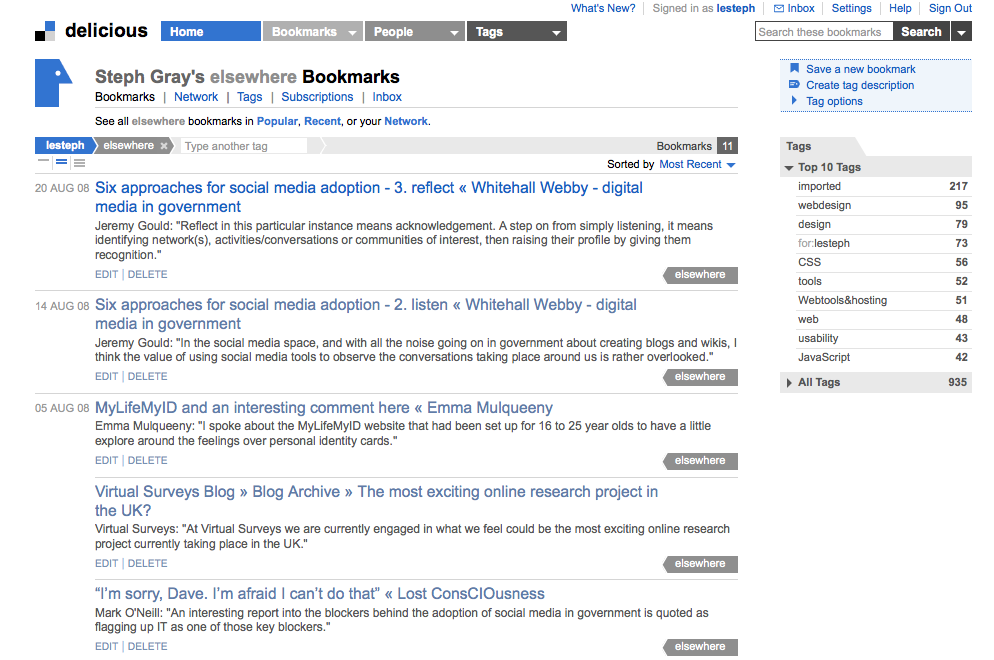Photo credit: ilse
Last week, Stephen Hale wrote a great piece on how to say no to new websites in the nicest possible way. I quite agree with him, and his analysis that most of the time, people say ‘I want a new website’ when they really mean that they want their issue or campaign to be communicated effectively online.
So when yesterday, Social Media Today directed us to Build Channel, or why Microsites are a Bad Idea, I started wondering: what makes people ask for microsites in the first place?
There are a bunch of reasons, good and bad:
- Identity: people want their thing to have its own name online, with a nice URL to use in marketing, and its own distinctive look and feel – which may or may not be justified
- Measurability: they want to be able to tell how well their site works and get regular, good stats on traffic, referrers and search keywords for their project specifically
- Flexibility: they want more latitude than the normal corporate site allows, maybe using more space for video or displaying an RSS feed – and the corporate templates or CMS can’t handle it
- Distance: their thing is a partnership or an independent organisation and they want to show it’s at arms length from the mother ship
- Timing: it’s a short-term or urgent project, so it’s more cost-effective to set it up separately and take it down again afterwards than to make changes to the functionality and templates of a big platform
- SEO: (a rare one) people believe that a separate microsite will rank higher in search engines for the desired keywords or brand name
- Ego: (a rather more common one): people want to say ‘that’s mine’ and enter it for awards
- Hassle: getting it onto a corporate site can involve headaches, bureaucracy and compromise in many organisations; it’s easier to go it alone and build from scratch direct with an agency
I’ll put my hand up to setting up microsites for these reasons and others – and yet I also agree with the ‘build channel, not microsites’ logic. It’s self-evident that a big channel can send more traffic, be more cost-effective, and be a better long-term bet in terms of SEO and brand, if it’s an effective one.
So what makes an effective channel, and by implication, what does it need to offer to head off the calls for microsites?
- It’s not about strong corporate branding: or at least, it’s not about a rigid corporate visual identity across the site. Cbeebies, BBC Weather and BBC News manage to have some pretty radically different templates, but work within the umbrella channel brand. A good channel has a common purpose and personality, where the organisation’s style and proposition shows through the design and language of its various sites.
- It’s not about a monster CMS: I just don’t think a single CMS can ever quite stretch to cover all the needs a big organisation has – no, not even WordPress. So it’s better to choose the right tool for each job, using small (interoperable) parts, loosely joined with embedded code, APIs, RSS feeds or whatever it takes to link your content pages to your blogs, your email newsletter to your video hosting provider. More generally, a strong channel is integrated: with other corporate channels, with social media channels, with related and interesting content, and with other sources of evaluation. Flexible but specialised tools, well-integrated with each other is crucial to demonstrating why a new microsite is a second-best option: if you find yourself saying ‘it’s not possible to do that on our CMS’, then you’re fighting a battle you will (and probably deserve to) lose.
- It’s about stickiness: microsites build an audience from scratch, and generally try and keep them engaged for the length of the marketing campaign. That’s an expensive and inefficient way to do it. A good channel has segmented email lists and alerts, RSS feeds, good use of Twitter, good SEO, and strong partnerships within and beyond the organisation. It helps promote the new launch initially, and builds awareness and engagement with the organisation’s customers in related areas, and can sustain it for months or years, not just a few weeks.
- It’s about ownership: it’s human nature to want some control over the shop window, and to feel frustrated when your special project is forced into a standard template or told it can’t have the kind of functionality you see on blogs all over the web because the corporate site can’t do it. A strong channel gives internal clients a sense that they own their piece of the channel, and that within some sensible boundaries, it’s theirs to take in whatever direction they like.
- It’s about the package: it’s not enough to say ‘You have to’. There are good reasons why – with the limitations of big CMSes and the needs of individual projects – people want special functionality, custom templates or personalised analytics. The challenge for people like me then is to put together such a helpful, flexible, compelling package of design, functionality, promotion, integration and analytics that nobody in their right mind would want to go it alone and build a microsite. Because why would they?


Comments
[…] This post was Twitted by draml […]
I agree with your points.
I had a lot of experience in local gov (LG) in parrying these requests, thankfully I got the backing early on in my career of our web management group to keep all websites under the main umbrella.
Your points;
1 It’s not about strong corporate branding:
I too used the BBC as the example to win my arguments. I found that the main corporate “surrounding framing” (largely headers and footers, but sidebars and navbars) had to be visually “sent to into the background” and it was quite a trick to find the balance between being strong enough to stamp a corporate look, yet bland enough to support, and not clash with a bright green recycling template, multicolored childrens templates on another part of the site.
I’d say to anyone going down the same road for them study the BBC site carefully first, and come up with a “corporate framing” they can sell internally.
2 It’s not about a monster CMS:
If you’ve bought into the one CMS for all solution, and have not left doors open to create your own applications, well you are goosed anyway.
6 It’s about the package:
Much as the previous point really, if you don’t have the wherewithall to be able to bend your IT to suit your (internal) clients then it is natural that the site will fragment into microsites.
In fact the plethora of microsites in local government over the years are testimony to the overall failure of web teams (pre-ordained to fail by committees spending cash on IT structures they barely understand), and are an anti-pattern in their own right.
The other point I would make is the SEO argument – that can be blown out of the water at any moment, how can a brand new domain compete with probably 10 years of SEO history of your main domain?
I also used to throw into this argument all the ways I was able to cross link internally to the new section, how we could build links to it from other sections’ news, articles, faqs, how this owner could do an “internal sales job” and pressurise others working on the site to provide links to this new section.
This is especially true in LG where locally after 10 years of good SEO you have already dominated searches for local names (or should be the case).
Phew! Its a relief to know we are not the only team to have these difficult conversations.
In my experience security and support are also a big factor and persuading people that their channel should come under the main umbrella. There are many examples of flaky, difficult-to-manage microsites, hosted externally, which have caused problems and ultimately let down their intended audience.
Thanks for a really interesting article.
This is so well put Steph – I particularly love the “monster CMS” bit!
If I were to amplify any of these, it would be the point about organisational scale, and the control issues that come with this. You touch on it in the ‘ownership’ and ‘hassle’ sections – but there’s more perhaps to this than simply the ownership issue of any individual area.
When organisations – and channels – exceed a certain size their very scale and complexity make clear and fast decisions extremely difficult. This is something that’s always faced in an organisation growth model – often the hardest thing to overcome in the longer term; as formal governance structures struggle to keep up with the speed and flexibility of control required.
@paul_clarke
[…] Why do people want microsites? at Helpful Technology – Excellent stuff from @lesteph […]
Twitter Comment
[Global] DavePress » Bookmarks for November 16th through November 18th: Awesomeness off of the internet for Nove… [link to post]
– Posted using Chat Catcher
This comment was originally posted on DavePress
Well, the challenge is to define ‘website’ – you yourself have built microsites in the sense of standalone, unconnected sites, but also sites which are mechanically separate and innovative but add functionality to an existing channel by slotting neatly in with them.
I’m all for building, and maybe until fairly recently, I’ve been quite gung-ho about microsites. But the reality is that separate sites often struggle for attention, commitment and maintenance from their owners, compared to sites within the fold of a bigger channel.
This comment was originally posted on Puffbox.com
[…] Why do people want microsites? (from Helpful Technology blog) (tags: websites strategy development) […]
But you have raised an excellent point that has been overlooked – how you ensure skils development if people aren’t actually doing any development work. Sadly it might result in all development work being done outside government at stupid cost. That’s a nice problem to solve for those who have made it. But then we know that encouraging innovation inside a large bureaucracy is hard at the best of times.
This comment was originally posted on Puffbox.com